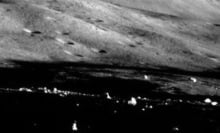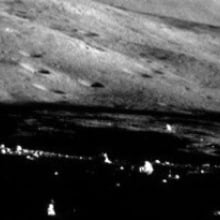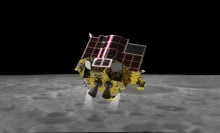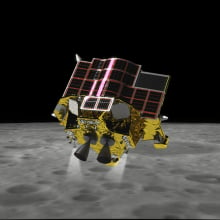The first words uttered by a human standing on the moon are iconic. But so are the words from the second brazen astronaut.
"Beautiful, beautiful. Magnificent desolation," marveled NASA astronaut Buzz Aldrin.
Indeed, the moon's powdery surface is a harsh, airless, inhospitable place, a world that reaches 250 degrees Fahrenheit (121 Celsius) and drops to -208 F (-133 C) at the equator — though NASA has recorded temperatures of -410 F (-246 C) in the permanently shadowed lunar craters.
But the desolate moon holds surprises and still undiscovered secrets. Below you'll find curiosities about the moon's past, present, and future.
The moon is moving away from Earth
Our natural satellite is on average some 238,855 miles away from Earth. But it's gradually departing.
"The Moon is slowly moving away from Earth, getting about an inch farther away each year," NASA explains.
Energy from the spinning Earth is transferred to the moon, ultimately pushing it farther out. This gradual separation will continue for billions of years. Meaning the moon will one day be 100,000 or so miles farther away in some 5 billion years, when our sun expands and dies.

The moon has quakes and tremors
The moon still shakes and rattles.
This world experiences seismic activity, aka "moonquakes," the first of which were recorded by seismometers left on the lunar surface by Apollo astronauts. The instruments recorded over 13,000 quakes, and not all the temblors were small.
"Some of these quakes can be fairly strong, around five on the Richter scale," Thomas Watters, senior scientist in the Center for Earth and Planetary Studies at the Smithsonian’s National Air and Space Museum, said in a statement.
Planetary scientists suspect that the shrinking moon, under a third the width of Earth, is triggering these quakes. "Just as a grape wrinkles as it shrinks down to a raisin, the Moon gets wrinkles as it shrinks," NASA explains. "Unlike the flexible skin on a grape, the Moon’s surface crust is brittle, so it breaks as the Moon shrinks, forming 'thrust faults' where one section of crust is pushed up over a neighboring part."

Moon dust is dangerous
When NASA journeyed to the moon, the space agency found that lunar dust was a major problem. It "clogged mechanisms, interfered with instruments, caused radiators to overheat, and even tore up their spacesuits," NASA explained. And if inhaled, lunar dust could damage lungs.
"The dust is very fine, abrasive and sharp, like tiny pieces of glass, making it more of a dangerous threat than just a simple nuisance," Sharon Miller, a NASA research engineer, said in a statement.
That's because, unlike on Earth, soil and rocks on the lunar surface aren't smoothed down and eroded by water and wind. So it's a damaging environment. As NASA prepares to return astronauts to the moon (the Artemis program), the agency seeks to mitigate dust damage to its rovers, spacesuits, power systems, and beyond.
"Dust is going to be the environmental problem for future missions, both inside and outside habitats," said Harrison “Jack” Schmitt, a geologist and Apollo 17 astronaut.
Astronauts have left interesting things on the moon
The moon is both a museum and a dump. Human explorers have left a variety of objects, often out of necessity. Here are some examples.
- Human waste: There are 96 bags of poop on the moon.
- Human ashes: NASA's Lunar Prospector probe carried astronaut Eugene M. Shoemaker's ashes to the moon in a protected capsule in 1999. "We will always know when we look at the moon, that Gene is there," said Carolyn Shoemaker, an astronomer and wife of Eugene Shoemaker.
- Golf balls: It's not fiction. Astronaut Alan Shepard really brought a couple of golf balls to the moon, and launched them across the lunar surface.
- Hammer-Feather Drop: Live on TV in 1971, Apollo 15 Commander David Scott dropped a feather and hammer at the same time. "Because they were essentially in a vacuum, there was no air resistance and the feather fell at the same rate as the hammer, as Galileo had concluded hundreds of years before — all objects released together fall at the same rate regardless of mass," NASA explained.
Some parts of the moon have "comfortable" temperatures
The moon's surface is notoriously harsh. It reaches up to 260 Fahrenheit (127 C) in daytime and plummets down to -280 F (-173 C) in the lunar night.
Yet NASA has identified pits on the surface that "hover around a comfortable 63 F (about 17 C)." The space agency's moon satellite, the Lunar Reconnaissance Orbiter (LRO), captured environmental data about these pits, some of which are collapsed lava tubes (created long ago when lava oozed under the lunar surface).
"Lunar pits are a fascinating feature on the lunar surface," LRO Project Scientist Noah Petro said in a statement. "Knowing that they create a stable thermal environment helps us paint a picture of these unique lunar features and the prospect of one day exploring them."

These pits don't simply provide pleasant temperatures. "The pits or caves would also offer some protection from cosmic rays, solar radiation and micrometeorites," NASA explained.
Chunks of the moon may be lodged in Earth
There are two giant masses of rocky material inside Earth, made of different elements than the rest of Earth's interior. Scientists think these masses came from a violent collision — the same one that created the moon.

Geologists suspect that an object dubbed "Theia," which at the time was a smaller planet, collided with early Earth. Earth absorbed much of Theia, and the rest amassed into what is now the moon.
"It appears that Earth's blobs are remnants of a planetary collision that formed our moon," Ed Garnero, a professor at Arizona State University's School of Earth and Space Exploration, said in a statement. "In other words, the massive blobs currently inside Earth, deep beneath our feet, are extraterrestrial. Earth not only has 'blobs,' Earth has extraterrestrial blobs!"
This story has been updated with more facts about the moon.
Topics NASA





























